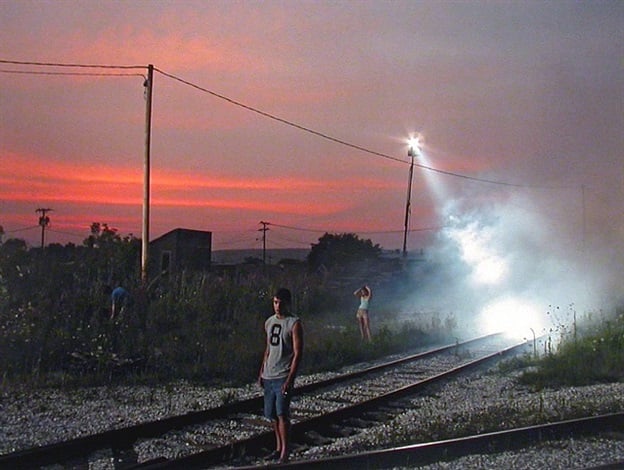
Photo: ClampArt
Gregory Crewdson’s photographs of suburban America, immaculately staged and often filled with a sense of isolation, have forever changed the language of contemporary photography.
Influenced by Diane Arbus and David Lynch, Crewdson’s work contains a kind of peaceful stillness, melancholy, and the familiar foreboding menace of suburbia. Staged and composed with a level of detail akin that of a movie set—complete with actors, props, cherry pickers, and precise directing from Crewdson himself—the advanced level of detail lends his photographs a deeply surreal quality despite the often “ordinary” subject matter they depict.
“I’ve always been interested in the commonplace, in finding a sense of beauty and mystery in everyday life,” Crewdson told American Photo magazine in 2014. “I’ve always been interested in the psychological nature of pictures, in trying to explain my own fear, and anxiety, and desire in photographs. The pictures are my means of trying to find meaning in the world.”
Born in 1962 and raised in Park Slope, Brooklyn, Crewdson graduated high school early and attended SUNY Purchase, studying photography during the 1980s. He then went on to complete his masters of fine arts at Yale University, where is now director of graduate photography studies and has been a member of the faculty since 1993.
He credits seeing a Diane Arbus exhibition at The Museum of Modern Art, taken by his psychoanalyst father at the age of 10, as sparking the first moment when he decided to become a photographer.
“It gave me an inkling of the power of pictures,” he recalled of the visit to American Photo. “But I didn’t start taking pictures until I was in college. I had a crush on a girl who was photo major, and followed her into a photography class. My Photo 1 teacher was Laurie Simmons, and my crush went from the girl to my teacher. As soon as I took my first pictures, my crush shifted from the teacher to photography.”
During his teenage years Crewdson was also member of punk band The Speedies, whose ironically titled song, Let Me Take Your Photo, was used in a Hewllet Packard advertisement in 2005.
Gregory Crewdson Untitled (from Natural Wonder) (1992)
Photo: courtesy Adam Baumgold Gallery
Crewdson’s first exhibition was held at Yale in 1988, and thereafter his career began to slowly gain momentum. His work at this stage was based around small staged scenes and dioramas which he would meticulously construct, light, and then photograph.
Gregory Crewdson Twilight (Beer Dream) (1998)
Photo: courtesy Photology
As he began to enjoy more success, Crewdson began to exhibit nationally and then internationally throughout the 1990s. In 1995, Crewdson exhibited his work at the White Cube Gallery in London with the seminal show “Gregory Crewdson: Photographs.” White Cube still represents him in the British capital, though Gagosian Gallery now represents him internationally.
By the late 1990s, the photographer began to stage increasingly elaborate shoots, creating high-production cinematic works with a level of craft and detail that regularly surpasses those of many feature films. From hand-painting patches of moss the correct shade of green to staging large-scale fires, Crewdson hires huge teams to work both behind and in front of the camera.
Gregory Crewdson Man in the Woods # 5 (2005)
Photo: courtesy Lorena Ruiz de Villa Art Advisors, S.L.
“I always loved movies and the look of movies,” Crewdson explains to American Photo. “I’m also a huge student of movies—but could never make one. Working in a linear fashion is foreign to me. I was always interested in using aspects of film production towards a single image—the relationship between movie making and still photography—and blurring the lines between the two. I’m fascinated with telling a story in a single image rather than through time.”
The still, emotionally charged scenes in the artist’s work have a brooding quality, but also sometimes real sense of peace. In his photographs, you might see a light shining down from the sky, or a mother observing her sleeping child, for example. But there is also a real sense of isolation, alienation, and aspects of the grotesque haunting his oeuvre. He cites both David Lynch’s Blue Velvet (1986) and the work of Japanese silent film director Yasujiro Ozu as direct influences on his aesthetic.
“David Lynch’s Blue Velvet […] would be the movie that defined me as I was coming of age. I encountered it when I was a graduate student at Yale. I remember feeling deeply connected to how it used the American vernacular, and revealed something more dark and sinister underneath it. I was also completely connected to the way it looked: the use of light and darkness. I’m not saying it’s the best movie ever made, but the one that defined me the most.”
These sensibilities are perhaps exemplified in the series Underneath the Roses (2005) the making of which was made into the critically acclaimed documentary Greogory Crewdson: Brief Encounters (2012), by the award-winning documentary filmmaker Ben Shapiro.
Gregory Crewdson Untitled (18) (2009)
Photo: courtesy White Cube
In a recent series, Crewdson abandoned his typically elaborate approach, opting instead to photograph abandoned film sets just outside of Rome. These images, among other similar series, are strikingly different from his previous work in that they are black and white shots featuring no people, animals, or obvious narrative, posing questions rather than answers or psychoanalytical summations.
Whether or not the change in Crewdson’s work will see him taking a whole new direction with his art is yet to be seen.